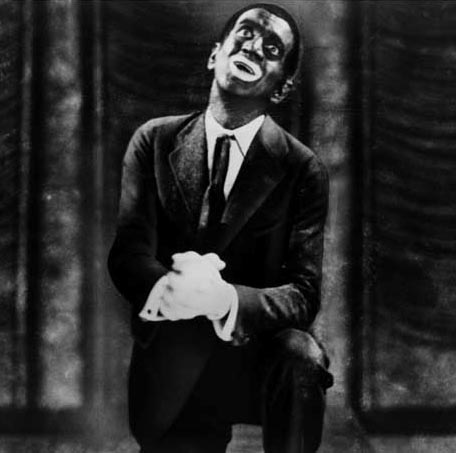The first commercial film with music
Do you remember the name of the first commercial film that used music?..........
..............That's it! The Jazz Singer, in 1927. It's about a young man who wants to be a professional jazz singer but his father doesn't agree with his plans, so he has to leave home to pursue his ambition. It was a huge success: the public in the cinema were so surprised with the new techniques that they shouted and clapped a lot!
Here is a photo of the main actor in that film, Al Jolson:

And here is a photo of Al Jolson in the film "The Jazz Singer".
What is the biggest difference between the two photos?

Anónimo. The Jazz Singer 1927 . (Dominio público.)
In the second, his face is painted black. This use of black make-up on white actors, called "blackface", is a fashion which goes back many, many years, and is racist and offensive to us today. It was common in the theatre and on television in those times. Now let's find out about this and also about the techniques used in this first commercial film with music and also spoken words.
Read about the techniques
The Jazz Singer is an 89-minute-long film with a synchronized recorded music score and also lip-synchronous singing and speaking, although it also still uses the caption cards that were used until then, with written information which the public had to read to know what was happening in the story. For the sound they creators of the film used the technique sound-on-disc, using a phonograph or another type of disc to record and play back sound in synchronization with a movie. Early sound-on-disc systems that were used when "The Jazz Singer" was made had a mechanical interlock with the movie projector (more recent systems use timecode).
The 1927 Warner Brothers’ movie The Jazz Singer is usually remembered as the first talkie; that is the first feature film that used audio. Although it was not actually the first motion picture with synchronized sound, it did represent a landmark in the history of film.
Following on the heels of numerous previous attempts to link sound and motion pictures, Western Electric demonstrated its sound-on-disc system in 1922. In 1925, Western Electric employee Nathan Levinson saw a demonstration of the system in New York and convinced motion picture producer Samuel Warner to give it a try. The first feature-length film produced by the Warner studio with the new equipment was the 1926 film Don Juan, which featured music and synchronized sound effects but no speech. The second feature film that used this new equipment was The Jazz Singer, which opened in October 1927. It, too, was mostly a silent film set to music, and even had the traditional “title cards” to indicate the dialog of the actors, but some of the music included vocal parts. At one point lead actor Al Jolson looked into the camera and spoke lines that included the famous words, “Wait a minute! Wait a minute! You ain't heard nothin’ yet. Wait a minute, I tell ya, you ain't heard nothin’!” The era of the talkies was launched.
Alfred A. Cohn's screenplay was an adaptation of a live Broadway production written by Samson Raphaelson, called The Day of Atonement. The plot follows the struggles of the son of a Jewish cantor, who yearns to sing popular songs at the local saloon, but who is pressured by his father to follow in his footsteps. The film in its entirety lasted 89 minutes.
The commercial success of The Jazz Singer, was due largely to the spectacle of Al Jolson’s spoken lines. This triumph encouraged other motion picture producers to experiment with synchronized sound. It was so alluring that the very next year, in 1928, Warner exhibited his first film where all of the spoken lines were recorded rather than flashed on the screen on title cards.
Read about the use of blackface in films and TV
Blackface is a technique that is considered racist today. Really it goes back many, many years, even to when black people weren´t allowed to act in theatres and white people played their parts, such as in Shakespeare´s "Othello". The BBC (the British television) had a programme called "The Black and White Minstrel Show" which ran to the 1970s, until the Campaign for Racial Discrimination denounced it, and it is mainly considered an embarrasment now. However, the history of blackface is interesting. For example, it is strange but even some black artists used blackface and argued that on films and TV it helped to bring black culture and music to white audiences. It is also true that for them it was very difficult to get a job in films, particularly in those years. Al Jolson used the technique in this film, but he defended civil rights (the rights of Afro-Americans) in America and he was defended in some African American publications.
READ this article about blackface:
Here is something for you to debate about with your teacher and your classmates:
do we use blackface in Galicia?
.....No? Are you sure?
Extra reading
Licensed under the Creative Commons Attribution Non-commercial Share Alike License 4.0